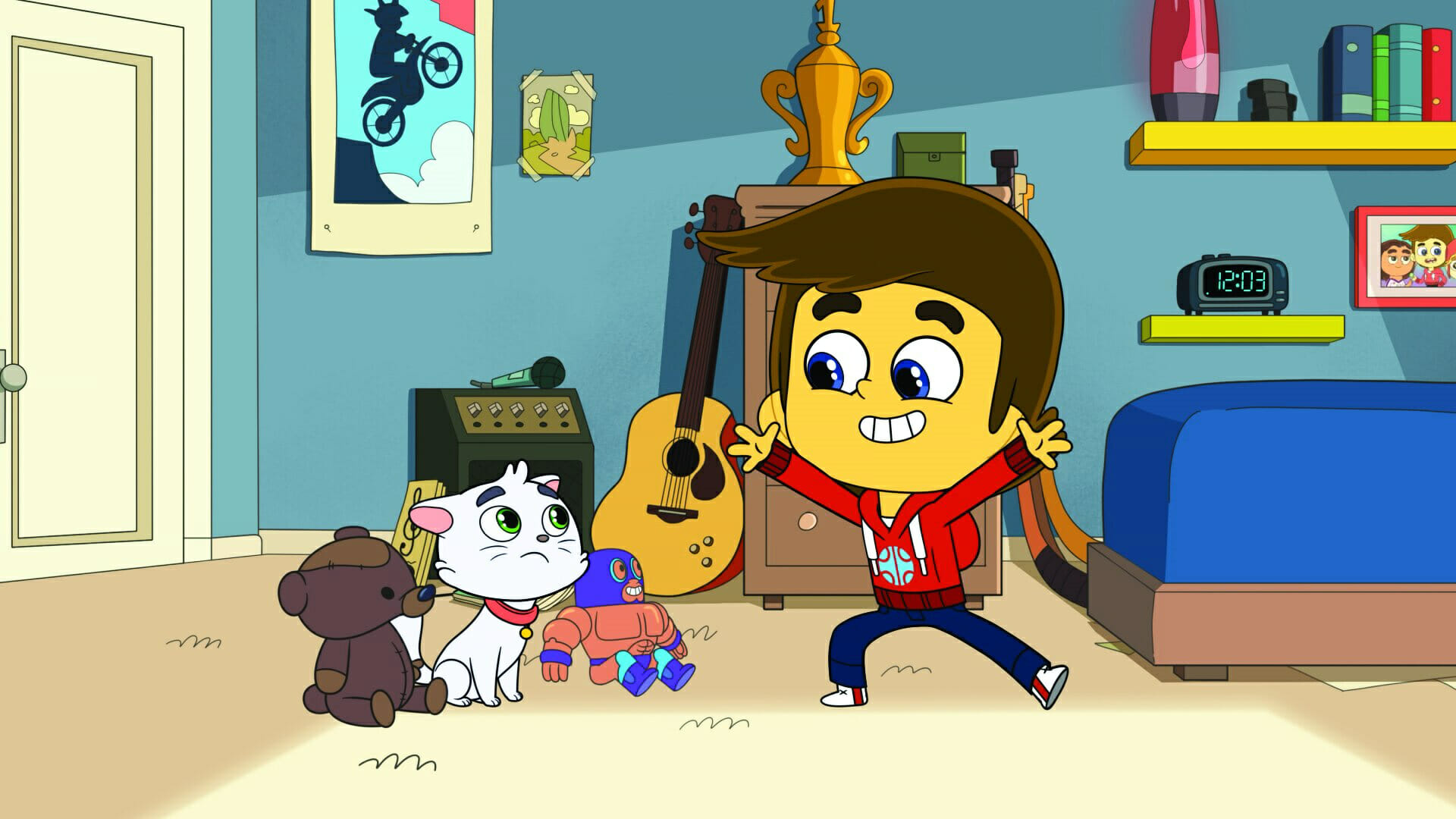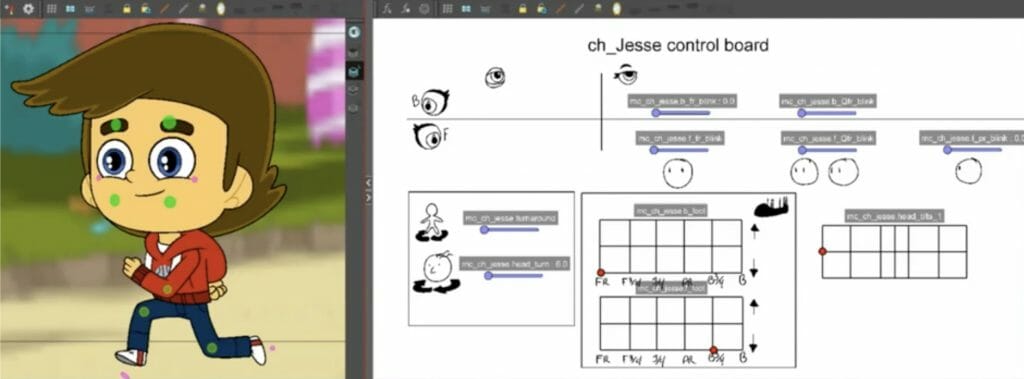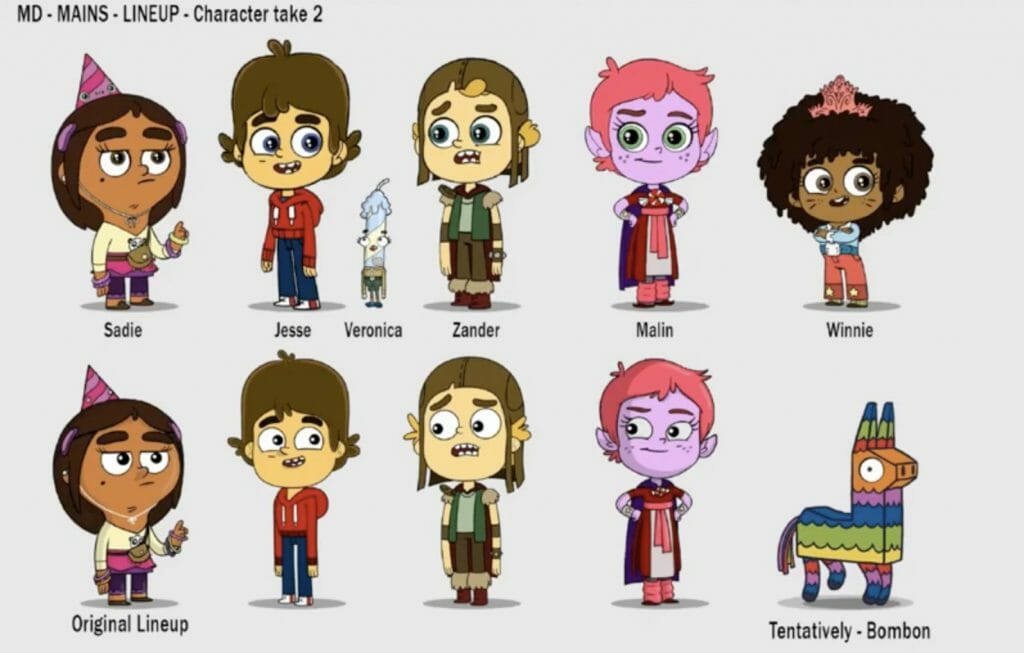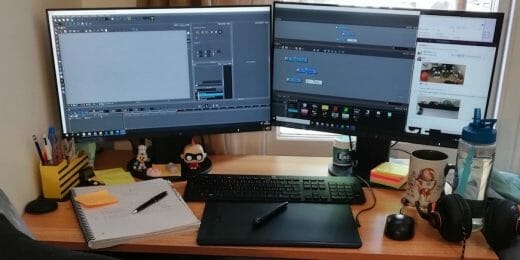
Super Wish is an animated children’s series from Redknot, a joint venture between Discovery and Nelvana. In this children’s series, a young boy accidentally wishes his birthday party to disappear, and to his surprise – it does! He and his friends are transported to a magical realm known as The Happy Land of Birthdays. They must venture through the realm to track down and un-do his Super Wish in order to get back home.
Super Wish was created by Vanessa Esteves (supervising creative producer, series creator and showrunner) and Adrian Thatcher (director and co-creator). We caught up with Vanessa, Adrian, and Daniel Clermont (animation director) during the 2023 Animation Trends Event to discuss the development and production that went into Super Wish. The following article is an excerpt from the interview, which you can watch in its entirety below.
How was Super Wish pitched, and what were the early meetings with networks like?
Adrian: Vanessa and I compiled a very detailed pitch package. It had tons of information, including the show concept, information about our main cast character traits, series tone, and a little bit about the world the series takes place in. When you go to pitch, you need to be able to answer any questions that may be thrown at you, and so your pitch package should be chock full of details.
When we talked to DKLA for the first time, we didn’t have to answer any curveball questions, because they were really taken with the series concept right away. They saw a lot of potential and excitement for the concepts of birthdays. Birthdays have been sprinkled into other series, but never made to be part of the actual narrative of a show. DKLA loved it, and came on board.
Vanessa, for those who may not be familiar with Super Wish, could you describe the series, and the characters that appear in it?
Vanessa: I like to describe Super Wish as a childish imagination that’s come to life, with an underscore. It has a real Alice in Wonderland feel to it. The series is about a boy named Jesse Cameron, who makes an unfortunate wish on his 10th birthday.
It all starts when he wakes up expecting an older kid birthday party, with activities like go-karts and laser tag. But, he discovers that his mom has planned for him the exact same birthday party he’s had for years. A party typical for younger kids, with the entire extended family invited – which is not what Jesse had in mind.
When it comes time to blow out his candles and make that birthday wish, he mumbles under his breath that he wishes his whole birthday party would just disappear. What Jesse doesn’t know is that on his 10th birthday, he gets a super wish rather than a regular wish. And so of course, when he makes this super wish, his birthday actually does disappear.
Jesse, his two best friends, his cousin, and everything in the room that has to do with birthdays, is pulled into a vortex. The kids are magically transported to the birthday dimension known as the Happyland of Birthdays.
Once they arrive they realize they realize they are stuck there, and the only way for the kids to get back home is to reverse the magic. They need to track down Jesse’s super wish, which has become its own character to do so.
How did Super Wish differ from other productions Nelvana has worked on?
Adrian: One major difference with Super Wish was of course, that Vanessa and I created it. We’ve worked on many productions in the studio that come to us from other creators and other broadcasters. Although they’re always a pleasure to work on, they come to us with a specific vision – and so these productions aren’t a brainchild to us like Super Wish is.
Vanessa and I doubled as showrunners on Super Wish, so we were involved in all aspects of production, including enterprise decisions and marketing. Having that overarching input was amazing.
Vanessa: Another big difference was that Super Wish was the first show we produced during the pandemic. This made it unbelievably different from productions we had done in the past. The show had been in development for three years, which sounds like a long time, but there were starts and stops during that period.
We got greenlit to make Super Wish just as the world started shutting down from the pandemic. Suddenly, we were all working from home. We didn’t sit in a room together again for at least a year. This meant that everything about the production was set up different, from our record and story, to story summits.
What were the first steps in starting production?
Daniel: Adrian and Vanessa shared with me lots of information about the show’s concept, story, and the personalities of each character. We talked about what motivates each character, how they think and feel, and their role within the world of the series.
For example, I learned about Jesse’s little cousin who is the youngest one of the kids, and a little less confident. She has an arc of developing confidence throughout the series. All that background information was really helpful for us when we started planning the episodes. It helped to guide our process when storyboarding.
At the start of a new production, there’s typically new tools, techniques, or tips you’ve learned from the previous production or other artists that you want to bring with you. For Super Wish, we went to Adrian with a few ideas for new tools and techniques we could use, one of which was master controllers.
Super Wish was my first show where we used the master controller workspace, and it was tons of fun. I had known of it, but hadn’t ever used it before. We had a lot of coordination with our technical director (TD) Andrew, and his rigging team. He provided us with a good preliminary master controller rig. With some testing, and feedback from Andrew, we were able to work with the TD and his team to get the controls we wanted for it.

How was your experience working with master controllers for the first time?
Daniel: I found it really fun. I’m sure anyone who’s animated in Harmony knows, you have to pose your character and then you work with pegs. I like to compare this process to sculpting, because you start with the big chunks. You’re gonna move the main peg, and then the leg peg, and then the lower leg peg, and so on. You pose your character then go in to fine tune it with the envelope deformer. The master controller really speeds up this process, especially if you have poses loaded into it.
Could you share a bit about the storyboarding process for Super Wish? And were there features of Storyboard Pro that were especially helpful?
Adrian: Similar to how we used this project to experiment with master controllers, there were tools and features in Storyboard Pro that we were excited to try out as well. We took the opportunity to use z-depth, and also played around with the character rotations and panning elements in Storyboard Pro. I know that some of the features we were using for the first time have been around for a while, we just hadn’t had the chance to use them yet.
It actually ended up that one of those dynamic rotation scenes made it into the first episode. It shows a rotation of the characters as we’re panning the background. The beauty of this is that we were able to iron out the technical details of the scene in Storyboard Pro. Because it’s so robust, we’re able to get a leg up going into animation.

We’ve touched on development and storyboarding, so I’m curious, what was the animation pipeline like for Super Wish?
Daniel: The pipeline started with those early meetings I had with Adrian, where he talked me through the show’s concept and characters, and he shared references with me. At the start of production, we had about half the team assembled as we ramped things up. During that period we produced tests and examples, and showed them to Adrian to see what worked and didn’t work. We used his feedback to iron out the style of animation.
I’m very fortunate that Adrian trusted me a lot. He would chime in, but never micro-managed. When he did have chime in, it was always golden advice. In general we would chat once per episode, maybe a little more than that, but his feedback was always very constructive and valuable. We always applied his feedback to the next episode, and I think you can kind of see that evolution throughout the series. Every episode looks even better than the last.
As animation director, how did you develop an animation bible for the team, and help to guide them in keeping the style cohesive throughout the series?
Daniel: I’ll start by saying I had a lot of support from Adrian in this. He shared lots of reference work to share with the team, which helped immensely. When scenes came to me, I always did my best to be constructive in my feedback. I would explain how an animator could get back on style, and I also made sure to let them know when they had nailed it. Adrian also sometimes had a look at scenes and always shared positive feedback.
Vanessa, what was it like to see each of the Super Wish episodes you wrote come to life?
Vanessa: I could gush nonstop about the whole team, truly. From start to finish they were all incredible. All the way through production, every single step got better. This is how it’s meant to be in a production, but it felt especially amazing on Super Wish because we had a good idea of what we wanted it to be when we pitched it – but then all these other ideas came in from the team and they all just fell into lockstep together. Everyone who joined the team ended up staying on through to the end. We would joke that we were the “fellowship of the wish.”

Do you have any advice for artists who would like to work with studios on projects like Super Wish?
Adrian: My advice is for animators specifically, for anybody applying for performance stuff. We all know that animation is an exaggeration, it’s an illusion of life. We all know how to do this exaggeration well. I think something that can really elevate an artist, especially in the eyes of studios, is an ability to incorporate an emotional note. Being able to achieve those heartfelt moments is something that makes an artist stand out.
Vanessa: I’ll start by saying that if you’re applying to work on a show that is already airing, be sure to watch it. It seems obvious, but it’s so important. Watch the show so you have a frame of reference, can speak to its style and share an opinion on it. You need to be able to articulate why you are a good addition to the team.
If it’s a show that isn’t on air, find out the details about it before you interview. Ask your interview contact who the show’s audience is, what genre it is, and more. Find out whatever you can about the show, and then look for comparables. Educate yourself about what’s already on the market in that genre and age demographic. That way you have a frame of reference and can come to the interview with thought-out ideas.
Daniel: First of all, don’t give up. It’s important to actively practice your animation skills. And I agree with Vanessa that it’s super important to look at the show you’re interviewing for, or comparables, so you have a frame of reference. And to what Adrian said, yes, put your best stuff at the start of your reel. We want to push play and think, wow, we want to see more of this.
I’ll also share that I personally save everything that is sent to me for review. This way, if I see a person’s second reel, I can compare it to the first one I received, and see how they’ve been growing. Being able to see the evolution of their skills signals to me the work that’s been put in, and that’s a definite selling point. Finally, ask for feedback when you submit your work. Feedback is crucial!
- Interested in seeing more from Super Wish? Learn more from the series website.
- Wish you could try creating master controller rigs in Harmony Premium? Artists can download a free 21-day trial.



